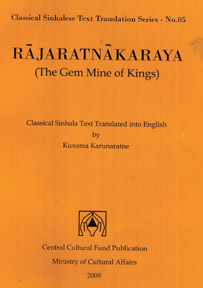|
Book review:
Lankan royalty re-introduced
Title: Gem Mine of
Kings
(Translation of ‘Rajaratnakaraya)
Translator: Professor Kusuma Karunaratne
Published: Central Cultural Fund, 2009
Sometime back when I visited Sigiri with my grandchildren, I came
across the English translation of the Rajaratnakaraya at the Sigiri
museum bookshop.
 But regrettably I had no time to purchase a copy. Knowing my interest
in this area, Professor Kusuma Karunaratne sent me a complimentary copy
of her work which I read with great interest. I am glad to note that she
has performed her task with much patience and sagacity. But regrettably I had no time to purchase a copy. Knowing my interest
in this area, Professor Kusuma Karunaratne sent me a complimentary copy
of her work which I read with great interest. I am glad to note that she
has performed her task with much patience and sagacity.
Apart from the translation itself, it consists of an introduction and
a glossary of unfamiliar terms for the use of English readers. The
introduction (1-11 pp) is thought-provoking and interesting, but, to me,
unpardonably brief. Her main interest has been to discuss the narrative
style of the text.
She has tried to explain why the meanings of the Pali stanza are
given by the author repeatedly in Sinhala.
To the English reader this would seem a repetition all the time. I
expected the sufficient attention had been given to the historicity of
the text, the subject matter as well. However it is obvious that the
text with the Pali stanza and a commentary in Sinhala need no further
explanation.
In the introduction, Kusuma Karunaratne has been very careful to
identify the narrative styles, attitudes, the tone etc of the authors of
the Dipavansa and Mahavansa nd compare with those of the
Rajaratnakaraya. Unlike the Pali Dipavansa and the Mahavamsa or the
Sinhala Pujavaliya and the Rajavliya, Rajaratnakaraya is not a connected
genealogy of kings in the chronological order, but to comply with the
aim of the writer, Pali stanzas have been selected from different texts
with a Sinhala commentary, regardless of the confusion caused to the
reader. Nevertheless, Kusuma Karunaratne has been extra careful to give
an intelligible translation. In this respect she deserves our praise. As
for the printed editions of the Rajaratnakaraya, she very rightly
records works of Ven Welitara Saddhananda Thera, Simon de Silva and of
course the joined edition of Ven Davuldena Gnanissara Thera and S J
Sumanasekara Banda, the text on which the translation was based. The
latest edition by Karunadasa Rupasinghe, Godage Brothers, 1995, is given
in a footnote, to complete the list. For the information of the modern
reader I wish to add translation of this text attempted by Edward Upham
upon the request of Sir Alexander Johnston titled ‘Sacred and Historical
Books of Ceylon, Mahanvansi, Rajaratnacari and Rajavali, London, 1833.
Professor G P Malalskeara in his introduction to his monumental work,
‘Pali Literature of Ceylon (1928)’ had made the following observation:
“It was found that his pioneer work was full of inaccuracies…” There is
no indication that Kusuma Karunaratne had made use of this translation
with ‘full of inaccuracies’ for her work.
As a person interested in translation work particularly of historical
texts, I fail in my duty if I do not take this opportunity to
congratulate Prof Kusuma Karunaratne for her untiring efforts in
bringing out a readable English translation of a complicated Sinhala
work, compiled during a decadent period of Sri Lankan literature and
history. |





